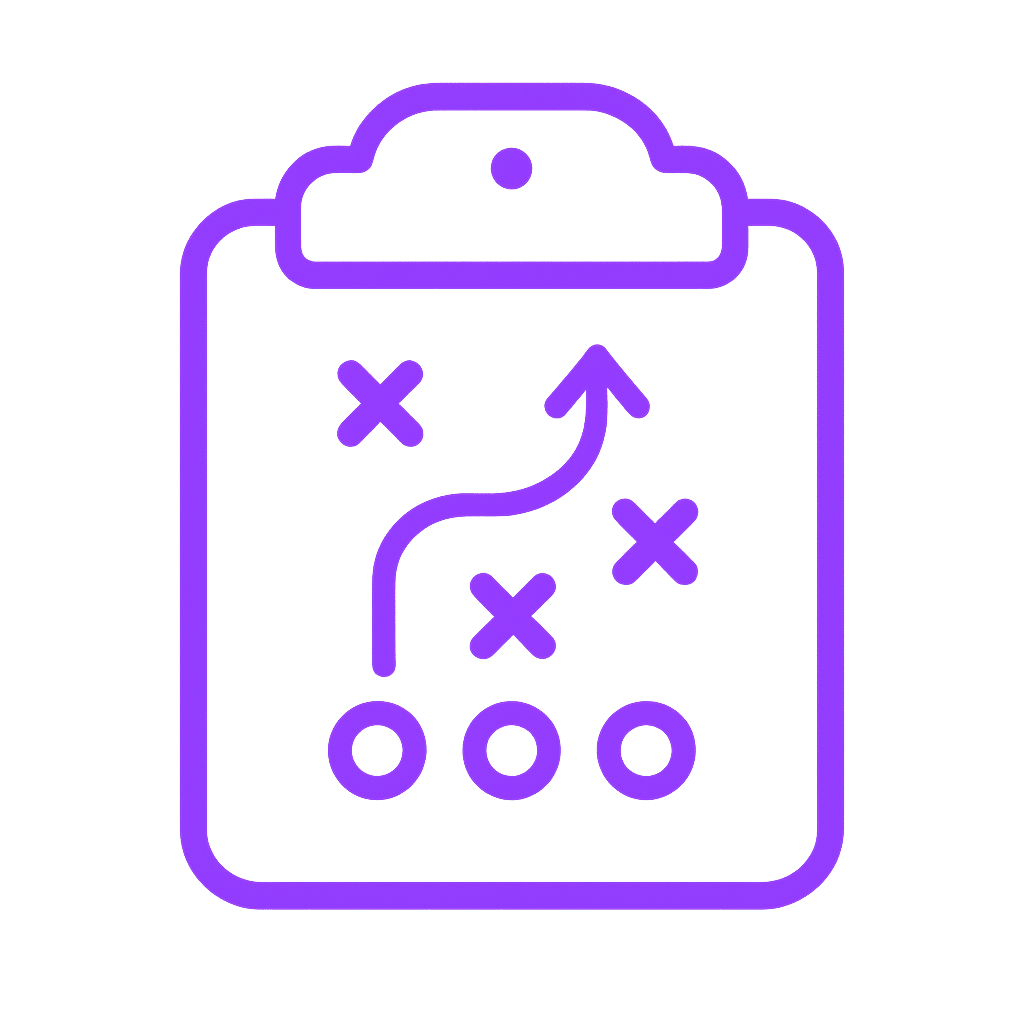
Accurate sales forecasting is like setting your GPS before a road trip. Without it, you’re driving blind, wasting fuel, missing turns, and arriving late. For businesses, that means poor resource allocation, inventory misfires, and missed revenue targets.
Imagine a retail brand overstocking winter jackets in a warm winter or a SaaS company hiring 10 new reps based on gut feeling—only to find the pipeline can’t support them. That’s the real-world impact of inaccurate forecasting: wasted capital, overextended teams, and unstable growth.
This is where Artificial Intelligence (AI) is rewriting the rules.
Instead of relying solely on historical sales charts and manual guesses, AI acts like a predictive radar system. It scans real-time market signals, customer behavior, economic trends, and sales patterns to forecast what’s around the next corner—with startling precision.
AI doesn’t just give you a forecast. It provides actionable, adaptive, and anchored foresight based on real data. Unlike traditional models that age quickly and lack flexibility, AI-powered sales forecasting continually evolves, refining predictions as new information becomes available.
In short, while traditional forecasting is like looking in the rearview mirror, AI forecasting is like flying with real-time radar—adjusting course to land exactly where growth is waiting.
Table of Contents
- What Is AI-Powered Sales Forecasting?
- Key Factors Influencing AI-Powered Sales Forecasting
- Revolutionizing Sales Forecasting with AI
- Choosing the Ideal AI Model for Sales Forecasting
- Benefits of AI-Driven Sales Predictions
- Implementing AI in B2B Sales Organizations
- Challenges and Considerations
- The Future of AI in B2B Sales
- Conclusion
What Is AI-Powered Sales Forecasting?

AI sales forecasting leverages artificial intelligence and machine learning algorithms to predict future sales by analyzing various data sources, including historical sales patterns, customer behaviors, and market trends. Unlike conventional methods that depend on past data, AI continuously refines its predictions by integrating real-time information, resulting in more accurate and actionable forecasts.
Lead Generation and Qualification
AI-driven analytics can help identify high-intent prospects, segment audiences based on behavior, and score leads automatically.
Sales Outreach Optimization
With AI, sales teams can determine the best times to contact leads, personalize communication, and automate follow-ups to improve engagement.
Key Factors Influencing AI-Powered Sales Forecasting
Historical Sales Data
Historical sales data plays a crucial role in identifying recurring patterns and trends, allowing businesses to analyze past performance and make informed decisions for the future. By analyzing previous sales cycles, companies can refine their sales projections and develop strategies that align with anticipated market behavior. Recognizing seasonal peaks, customer preferences, and product trends further enhances strategic planning, enabling businesses to optimize inventory management, marketing campaigns, and resource allocation.
Customer Behavior Analysis
Customer behavior analysis extends beyond traditional demographics by examining engagement signals, including website visits, email opens, and social media interactions. These insights offer a deeper understanding of customer intent, enabling businesses to predict purchasing behavior more accurately. By leveraging this data, companies can refine their sales strategies, personalize customer interactions, and generate more targeted leads, ultimately leading to higher conversion rates and improved customer retention.
Market Conditions
Market conditions have a significant impact on sales forecasts, as factors such as economic indicators, industry shifts, and competitive dynamics influence consumer behavior and demand. Understanding these external variables enables businesses to adjust their forecasts to account for broader trends, such as economic downturns, technological advancements, or regulatory changes. By staying aware of these fluctuations, companies can proactively adapt their sales strategies to maintain stability and growth.
Sales Pipeline Data
Seamlessly integrated with your CRM, ImpelHub maps every stage of the pipeline, flags stalled deals, and recommends the best actions — helping your team close smarter, not harder. Sales pipeline data offers valuable insights into the progression of deals through various stages, enabling businesses to monitor their sales funnel effectively. It identifies potential bottlenecks, measures conversion rates, and highlights areas for improvement. With a clear understanding of pipeline efficiency, sales teams can optimize their processes, address obstacles early, and enhance overall success rates by ensuring a smooth transition of leads through the sales cycle.
Seasonality and Demand Forecasting
Seasonality and demand forecasting allow businesses to anticipate fluctuations in sales cycles and prepare accordingly. By identifying peak and off-peak periods, companies can adjust their strategies to meet varying demand levels . This proactive approach ensures efficient resource allocation, optimized inventory levels, and better alignment of marketing efforts with consumer needs, ultimately improving profitability and operational efficiency.
AI-Driven Insights
AI-driven insights continuously refine sales forecasts by leveraging real-time data and advanced analytics. With the ability to process vast amounts of information quickly, AI can detect shifts in consumer behavior and market conditions, allowing businesses to make data-driven decisions with greater accuracy. These insights enable companies to respond to changes in real time, enhancing business agility and maintaining a competitive edge in a rapidly evolving marketplace.
Revolutionizing Sales Forecasting with AI

Processing Large and Complex Data Sets
AI surpasses traditional methods by incorporating not only historical sales data but also real-time insights, economic factors, and customer behavior patterns. This broad analysis improves the accuracy of sales forecasts, helping businesses identify trends with greater precision and confidence.
Reducing Human Error and Bias
Traditional sales forecasting often depends on manual data input and subjective judgments from sales teams, which can lead to inaccuracies. AI-driven models mitigate these biases by relying on objective, data-based insights, resulting in more consistent and dependable sales predictions.
Improving Speed and Efficiency
AI automates the process of gathering and organizing sales data, significantly cutting down the time spent compiling information from various sources. This enables sales and revenue teams to generate forecasts rapidly, allowing them to allocate more time to strategic planning and performance optimization.
Incorporating External Market Factors
Unlike conventional models, AI is capable of analyzing unstructured data from sources, such as social media, customer feedback, and economic indicators. This broader analysis enhances demand forecasting, helping businesses stay ahead of market shifts and make better-informed decisions.
Optimizing Sales Pipeline Management
AI-powered forecasting tools offer valuable insights into the sales pipeline by identifying stalled opportunities and potential risks. By analyzing customer interactions and behavioral data, AI helps sales teams refine their approaches, improving conversion rates and overall sales performance.
Adapting to Market Changes
While traditional models may struggle to adapt to sudden market fluctuations, AI continuously updates predictions based on real-time data. This ensures that businesses receive timely, relevant insights even in dynamic or uncertain environments, enabling them to make more agile, data-driven decisions.
Choosing the Ideal AI Model for Sales Forecasting
Selecting the right AI model for sales forecasting depends on the organization’s data availability, forecasting goals, and the complexity of the sales environment. Different models have unique strengths and limitations, so businesses must carefully consider factors like accuracy, data volume, and implementation complexity. Below is a comparison of popular AI-driven forecasting models, outlining their benefits, challenges, data needs, and ease of deployment.
1. Time Series Models
Examples: ARIMA (AutoRegressive Integrated Moving Average), SARIMA (Seasonal ARIMA), and exponential smoothing time series models are traditional statistical methods that use past sales data to identify patterns, seasonal variations, and cyclic trends. They work best when historical sales are reliable indicators of future performance, making them ideal for businesses with consistent sales patterns and minimal market disruptions.
- Suitable for businesses with stable sales data.
- Easy to interpret and computationally efficient.
- Requires minimal data preprocessing.
- Struggles with abrupt market shifts and external influences.
- Limited ability to handle unstructured data like customer behavior and economic changes.
Minimum Data Requirement: At least two years of historical sales data.
Implementation Complexity: Low to moderate.
2. Machine Learning Models
Examples: XGBoost, Random Forest, and Support Vector Machines (SVM)
Machine learning models are capable of analyzing large datasets and uncovering complex relationships between multiple sales variables. These models can incorporate both structured data (e.g., sales figures) and unstructured data (e.g., customer engagement, market trends), making them highly adaptable to changing sales conditions.
- Analyzes multiple variables for more accurate predictions.
- Adapts to market changes dynamically.
- Outperforms time series models with large datasets.
- Requires significant data preprocessing and feature engineering.
- Computationally intensive, especially for real-time forecasting.
Minimum Data Requirement: At least 50,000 sales records for optimal accuracy.
Implementation Complexity: Moderate to high.
3. Deep Learning Models
Examples: Recurrent Neural Networks (RNNs), Long Short-Term Memory (LSTM), Transformer-Based Models
Deep learning models utilize advanced neural networks to identify complex, non-linear patterns in sales data. RNNs and LSTMs are particularly effective for sequential data, such as customer interactions and purchasing behaviors. Transformer-based models can process unstructured data like social media insights and market reports, further enhancing forecast accuracy.
- Ideal for highly dynamic and complex forecasting environments.
- Can incorporate real-time data and external influences.
- Continuously adapts to shifting sales trends and market conditions.
- Requires vast, high-quality data for training.
- Computationally expensive and resource-intensive.
- Challenging to interpret and requires specialized expertise.
Minimum Data Requirement: 100,000+ sales records for optimal performance.
Implementation Complexity: High.
Benefits of AI-Driven Sales Predictions

1. Improved Forecast Accuracy
AI-powered sales predictions enhance forecasting precision by analyzing large datasets and uncovering hidden patterns. Machine learning algorithms allow companies to predict future sales trends with greater accuracy, reducing the likelihood of errors and enabling better-informed business decisions. This leads to more effective planning and improved financial stability.
2. Proactive Sales Strategies
AI-generated insights empower businesses to develop proactive sales strategies. By identifying potential opportunities and risks early, AI enables sales teams to adjust their approaches to meet evolving market demands. This ensures that sales efforts are more focused, strategic, and efficient, improving overall sales performance.
3. Optimized Resource Allocation
With more accurate demand forecasting, AI helps businesses allocate resources more effectively. Companies can ensure that the right amount of inventory, sales staff, and marketing resources are in place, minimizing waste and preventing issues like overstocking or stockouts. This results in greater operational efficiency and higher profitability.
4. Enhanced Customer Relationships
AI improves customer relationship management by predicting customer behaviors and needs. By analyzing customer data, AI models can identify patterns that guide sales teams on when and how to engage customers. This allows businesses to deliver personalized experiences, increase customer satisfaction, and foster long-term loyalty.
Implementing AI in B2B Sales Organizations

1. Data Collection and Management
The first step in implementing AI is gathering high-quality data, including historical sales, customer interactions, and relevant market trends. Effective data management ensures that AI models are trained on accurate and comprehensive datasets, leading to more reliable insights. Regular updates and data cleaning are vital to maintaining AI model effectiveness.
2. Choosing the Right AI Tools
Selecting the appropriate AI tools is crucial to the success of AI implementation. Organizations should assess different AI solutions based on specific needs, such as sales forecasting, customer segmentation, or pipeline management. It is essential to choose tools that integrate well with existing CRM systems to ensure smooth data flow and optimize AI performance.
3. Training and Change Management
Successful AI adoption involves both technical training for AI systems and skill development for employees who will use them. Sales teams and managers must understand how to interpret AI-generated insights and incorporate them into their workflows. Change management is essential to overcome resistance and ensure a smooth transition to AI-powered systems. Proper training and support will contribute to long-term success with AI in B2B sales.
Challenges and Considerations

1. Data Privacy and Security
When implementing AI in sales, protecting data privacy and security is paramount. AI systems rely on large amounts of sensitive data, such as customer information and transactional history. Organizations must adhere to data protection regulations like GDPR and CCPA and implement robust security protocols to prevent breaches and ensure that customer and business data remains secure.
2. Integration with Existing Systems
For AI tools to be effective, they need to integrate seamlessly with existing systems like CRM platforms and ERP tools. Integration challenges can arise, particularly with legacy systems or incompatible data formats. Ensuring smooth integration is essential for maximizing AI’s potential and facilitating real-time insights across the business.
3. Cost-Benefit Analysis
AI implementation comes with significant upfront costs, including software acquisition, training, and integration expenses. A thorough cost-benefit analysis should be conducted to ensure that the investment in AI yields measurable returns. This analysis should consider long-term benefits like improved sales performance, cost savings, and enhanced decision-making while accounting for challenges like implementation time and skill requirements.
The Future of AI in B2B Sales
1. Predictive Analytics and Beyond
As AI evolves, predictive analytics will remain central to B2B sales strategies. However, the future of AI extends beyond forecasting. Companies will increasingly use advanced predictive models to simulate business scenarios, optimize pricing strategies, and predict customer behavior in real-time, empowering sales teams to make proactive decisions.
2. AI-Driven Customer Engagement
AI is transforming how businesses engage with customers. In the future, AI-powered tools will predict customer needs and facilitate personalized, timely interactions. Automated chatbots, predictive customer service, and targeted marketing campaigns are examples of how AI can enhance customer engagement and build stronger relationships, driving customer loyalty and growth.
3. Continuous Learning and Adaptation
One of the most promising aspects of AI is its ability to continuously learn and adapt. As AI systems learn from new data and evolving market conditions, they will refine sales strategies in real-time, improving forecast accuracy and customer engagement. This adaptability will help sales teams respond quickly to changing business environments and maintain a competitive edge.
Conclusion
AI provides B2B organizations with a powerful tool for achieving sustainable growth. To maximize AI’s potential, businesses must invest in the right tools, ensure data security, and continuously adapt to emerging insights. By embracing AI strategically, organizations can position themselves for long-term success in an increasingly data-driven market. As AI continues to reshape B2B growth strategies, tools like ImpelHub offer more than just predictions; they provide growth blueprints that evolve with your business. With a modular, explainable approach to AI, ImpelHub helps leadership teams stay ahead responsibly and confidently.



